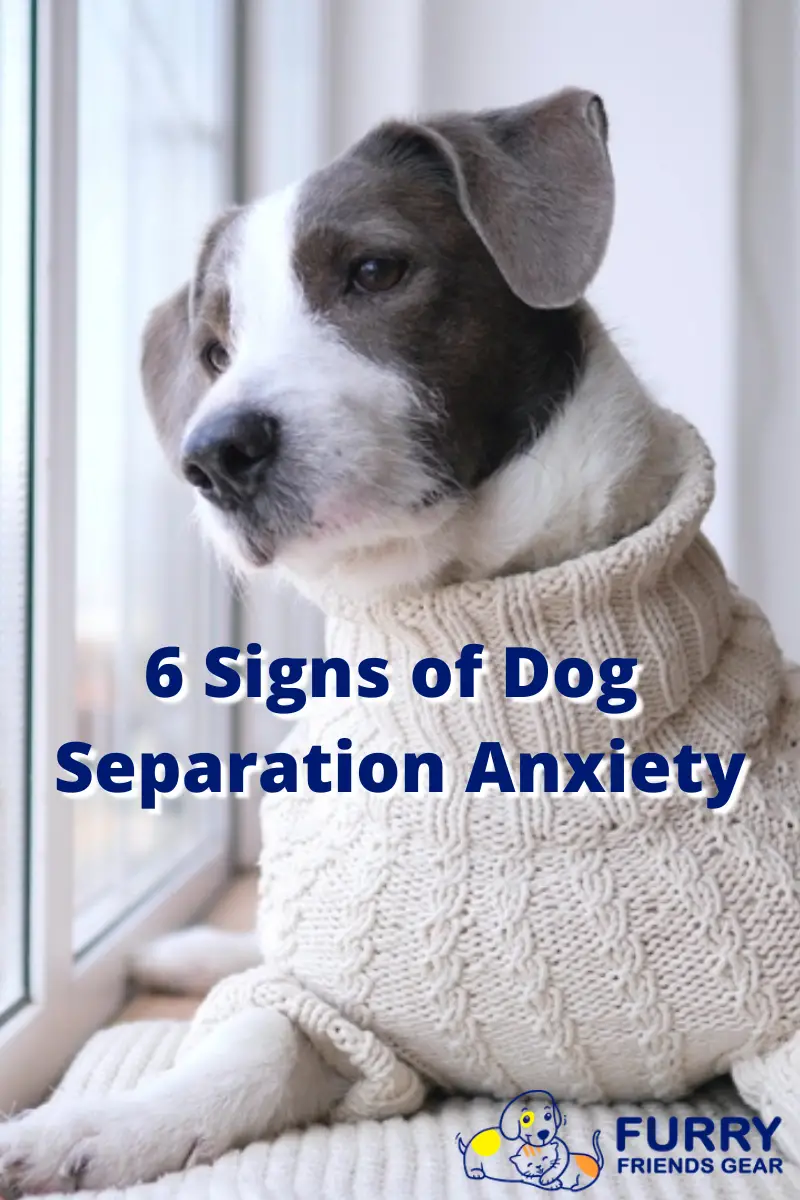Going to your 9-5 job and getting home to a house full of mess can always be very frustrating. There are puddles of pee everywhere, scratches on the floor, a bite mark on the furniture, household items torn apart, and a lot more crazy situations you can expect from your dog. These are signs of dog separation anxiety.
But even with all this mess, you are greeted by an overly excited pup who is happy to meet you after a long day. It’s like the best feeling in the world, and that greeting seems to make up for everything.
You get to work the next day, leaving a crying dog behind, and be greeted by the same scene when you get home. And no matter how much we love our pets, this kind of scenario can be stressful if it happens continuously.
However, what you may not know is that you’re not the only one stressed out. What if your dog is also undergoing a lot of stress every time you leave, which is why he becomes so destructive?
This type of behavior is what people would call separation anxiety. This is very common to a lot of dogs and is commonly triggered by small and drastic changes. It can also manifest in several ways, depending on the severity of the anxiety.
Below, we share the most common symptoms in dogs with separation anxiety and how to know if your dog does have separation anxiety.
Related article: Best Dog Toys for Separation Anxiety

Dog Separation Anxiety: Common Signs
As the name implies, dog separation anxiety is always associated with your dog’s behavior every time he’s separated from you. It’s either his behavior when he sees you about to leave, his conduct while left alone, or his behavior when you got home.
The symptoms can also range from mild to severe. It also varies from one dog to another. Dog owners need to detect dog separation anxiety when it’s not yet at dangerous levels. Here are some of the most common symptoms to watch out for:
Urinating or Defecating in the House
When dogs get stressed, most of them can no longer control the urge to pee or poop. So, if you get home with puddles of pee or traces of poop around your home, this could already be a sign that your pooch is suffering from dog separation anxiety.
However, you can’t immediately conclude this as there are other reasons why your dog is urinating or defecating in the house. It can also result from inadequate house training, not enough potty breaks, medical problems, or aging.
So, before you assume that your dog urinates or defecates, try to observe first. If your dog just does this whenever you leave, then it’s most probably dog separation anxiety. But if he does this, even if you’re around, there might be a much bigger underlying problem that you must find.
Excessive Barking, Howling, or Whining
If you get a call from a neighbor about how noisy your dog is whenever you’re not around, then it could be because of dog separation anxiety.
A dog howls, barks, or cries whenever he wants your attention, he’s in pain, he’s bored, or he’s stressed, and these are what he usually feels whenever you’re not around. For them, they will bark, howl, and cry, hoping that you’d come back.
Sometimes, this even happens when you just disappear right in front of their eyes. So if you’re home and you hear them whine, try to pay close attention to what kind of cry they’re making. If you think it’s because you got separated from them, don’t entertain it if possible to not make your dog think that he can get what he wants if he just cries.
Destructive Behaviors
We’ve probably seen a lot of videos on social media of how an owner gets home and finds a lot of household items torn up. Well, this is exactly what destructive behaviors mean.
Destructive behaviors can range from mild, like simple chewing, to destruction. And when it’s a separation anxiety-related destruction, these are some behaviors you can observe:
- Chewing on furniture, carpet, and other things they can see in the house.
- Chewing on personal items like your shoes, pillows, etc.
- Chewing or destroying your doors, windows, or window sills.
However, although dog separation anxiety is the primary reason why this happens, there are other possible reasons too. This includes boredom, health problems, general anxiety, stress, hunger, and teething (for puppies).
So, again, it’s best if you consult with a veterinarian who might be able to point out why your dog is behaving this way.
Trying to Escape
Another noticeable sign of dog separation anxiety is when they try to escape. Sometimes, due to loneliness, fear, and boredom, they’ll try to get out of the house to find you or somebody else to play with.
This causes them to scratch the floor at the main door or climb on window sills to find a way out, and this behavior can be hazardous for them. They can get injured trying to climb up to windows, they’ll hurt their paws, and many other accidents can happen.
To prevent this, it’s best to leave your dog with something that will entertain him while you’re not around. Perhaps some treats to find or toys to play with so he doesn’t get bored and attempts to escape.
Pacing
Although the pacing is usually associated with your dog’s boredom or excessive energy he needs to expel, this behavior can also be associated with stress, pain, anxiety, and separation anxiety.
Dog separation anxiety can be observed if your furry friend is pacing back and forth or walking in circles whenever he sees that you’re about to leave already. Sometimes, this happens even after you have left. For mild cases, pacing can be just brief, and your dog will stop. However, in severe cases, the dog might appear panicked, running from one exit to another.
Now, since pacing can also be associated with having a medical condition, it’s still always best to consult a veterinarian to determine if your dog really has separation anxiety. It also helps to determine if your dog has a mild or severe case of anxiety.
Excessive Salivation and Panting
Some dogs experience excessive salivation accompanied by panting whenever they’re left alone. This is usually brought about by stress and is common to dogs usually left in their crates.
So, when you get home, try to observe if your dog has excessive drooling. If he is, then perhaps it’s time to take him to the vet to know the exact reason why and so you can also get to rule out possible medical conditions.
Are You Kept Up At Night By An Anxious Dog?
We Share Great Tips & Tricks To Help Calm Your Dog Down At Night If They Have Nighttime Anxiety! Click The Button Below To Stop The Nighttime Anxiety.
Does My Pooch Really Have Dog Separation Anxiety?
Each of the symptoms above can be seen in dogs, regardless if they have dog separation anxiety or not. So, how can you pinpoint whether your dog does have separation anxiety?
To determine whether your dog has separation anxiety, you need to observe his actions. But how can you do this if you’re not around? Easy, you need the help of monitoring cameras or CCTV.
Get a pet monitoring system that comes with a wide angle. Then, install this in an area where your dog usually is. You should also make sure that the camera is in an area that your dog can’t reach.
When that’s done, time to observe your dog. Here’s what you should observe:
- How much time passed before your dog started showing signs of separation anxiety? This will be able to help you know how long it takes for your dog to become anxious. It might also tell you the severity of the anxiety and what actions you need to do.
- What symptoms does your dog show, and how long does this last? For example, if your dog exhibits howling or barking, how long before he stops? If they’re pacing, is it nonstop, or are they taking breaks? These will also help you determine the severity of the case.
- Where does your dog mainly focuses on his behavior? Is it at the doorway? Are they prone to just looking out the window waiting for you to come back? Is it on the household items and destroying them?
- Lastly, watch your dog every day and ask yourself if your dog is exhibiting these symptoms every day.
Write your observations down on a piece of paper and show this to the vet on your next visit. He’ll be able to assess how severe your dog’s anxiety is and how to treat it best. Below, we also share some things other dog owners do to help their dogs cope with separation anxiety.
Related article: How Do You Help A Dog With Separation Anxiety?

How to Treat Dog Separation Anxiety
1) Build Your Dog’s Tolerance for Alone Time
Teach your dog to become independent by building his tolerance for alone time. In other words, don’t let him come near you all the time.
As much as we love bonding with our pets every time we’re at home, this just makes them clingy. Hence, dog separation anxiety occurs when they can’t see us anymore.
So, when you’re at home, take him to a room. Pet him and calmly talk to him, but don’t mention anything about leaving as this will only make your dog anxious. After that, leave the room and close the door behind you.
Expect your dog to cry as he sees that you’re not with him anymore. However, don’t go back immediately. Try to observe how long it took before your dog started crying. Then, once he does, wait until he calms down or just wait for 5 minutes before you come back.
If your dog has a severe case of anxiety, don’t let it pass one minute before coming back. You can also leave some treats, and some toys behind that can entertain him, and remove any objects he can destroy.
It’s recommended to do this only once a day and gradually increase the amount of time you leave your dog in the room.
2) Prevent Your Dog From Following You Around
It’s cute when your dog starts following you wherever you go once you’re home. However, letting him do this will only teach him to become dependent on you. So, train him to stay whenever he’s following you.
You can also place some baby gates in areas where your dog is not allowed. This will give him some limitations on where he can and cannot go. Giving him a space of his own, his own bed, and a treat dispenser where he can get his own food will teach him that he can go on with a day even without you.
3) Change Your Going Away Signals
Dogs quickly get familiar with your actions, particularly when you’re about to leave. They understand that getting your keys, holding your purse, or wearing a coat is already a sign of leaving, and it makes them anxious. To reduce dog separation anxiety, don’t be afraid to change your routine!
So, it’s essential to change these going away signals. Maybe you can wear your coat even if you’re not leaving. You can grab your keys and sit on the couch for a moment. You can also go out in the back door for a change or place your purse in a different spot.
4) Be Calm When Arriving or Leaving Your Dog
Next, don’t be too overly dramatic when saying your goodbyes and hellos. This is one of the most common mistakes most dog owners make, and it’s time to change that.
When you’re too overly dramatic, you’re only triggering fear and anxiety. It makes your dog think that you’re scared about leaving them and will make them feel fearful, too. The same thing happens when you act as if you miss them so much when you return home.
5) Take Your Dog Out For Exercise
A tired dog is a calm dog, so take advantage of this fact. Take your dog out for an exercise before you leave. This will help him expel any excess energy so that he’s only more focused on eating or napping by the time he gets home. It’s the perfect distraction, so he won’t think about you leaving. Dog separation anxiety may likely be reduced through an hour of running around outside.
6) Feed Your Dog Before Leaving
Aside from taking your dog out for exercise, you should also feed your dog before leaving, as this helps him become more satisfied and relaxed. On top of that, get some treat-dispensing devices, too, so your dog can feed himself whenever you’re not around. You can hide some treats for your dog to find, too, to keep him entertained for hours.
7) Leave Some Toys
There are dog toys designed to help with dog separation anxiety, and it’s probably best to get your dog one. Make sure that the toy you get would be able to address what your dog needs. For example, if your dog needs some company, you can get a snuggle toy with a heartbeat simulator. If you want to keep your dog distracted, you can buy some puzzle toys.
8) Seek The Help of A Professional
Lastly, and certainly not least, ask for the help of a professional if the dog separation anxiety becomes a serious issue. A vet will always be the right person to tell the severity of your dog’s anxiety or if he even has one. He can also recommend the best practices you can do at home and even prescribe some calming aids for your dog to take.
Conclusion
Dog separation anxiety is very common, and it’s about time that it’s taken very seriously. By knowing what symptoms to watch out for, you’ll be able to know when to take your dog to the vet for a check-up.
Your goal here is not to wait until the anxiety reaches dangerous levels. The tips above will also help you support your dog so he can get over his anxiety. But, let me tell you, it will take a lot of time and effort from you.

